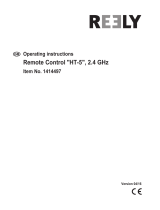
2
TABLE OF CONTENTS
INTRODUCTION ............................................................ 3
Additional Technical Help, Support and Service.......... 3
Application, Export and Modification .......................... 4
Usage Precaution........................................................... 4
Meaning of Special Markings....................................... 5
Safety Precautions (do not operate without reading).... 5
Introduction to the 7C ................................................... 7
Contents and Technical Specifications ......................... 9
Accessories.................................................................. 10
Transmitter Controls & Switch
Identification/Assignments.......................................... 11
Charging the Ni-Cd Batteries...................................... 14
Stick Adjustments........................................................ 15
Radio Installation ........................................................ 16
Range Checking & Link Procedure ............................ 18
Transmitter Displays and Buttons............................... 19
Warning and Error Displays........................................ 20
AIRPLANE FUNCTIONS ............................................. 21
Map of Functions ........................................................ 22
Quick Guide to Setting up a 4-channel Airplane........ 23
ACRO BASIC MENU FUNCTIONS ............................... 25
MODEL Submenu: MODEL SEL., COPYand NAME....... 25
Parameter(PARA.) Submenu: RESET,TYPE,CH5 & CH7 28
Servo REVERSE........................................................... 30
End Point (E. POINT) ................................................... 31
Idle Management: THR-CUT........................................ 32
DualRates and Exponential (D/R,EXP) ........................ 33
TIMER........................................................................... 36
TRAINER ...................................................................... 37
TRIM............................................................................. 38
SUB-TRIM..................................................................... 39
Fail Safe (F/S) (Throttle channel only) ...................... 40
ACRO ADVANCE MENU FUNCTIONS.......................... 41
Wing types................................................................... 41
Flaperon(FLAPRN).................................................... 42
Flap Trim(FL-TRIM).................................................. 43
ELEVON (see tail types) ........................................... 44
Tail types ..................................................................... 44
ELEVON.................................................................... 44
Twin Elevator Servos(AILVATOR)............................ 45
V-TAIL ....................................................................... 46
SNAP ROLL................................................................. 47
Mixes: definitions and types ....................................... 48
ELE-FLP.................................................................... 49
Air Brake(A.BRAKE) ................................................ 52
FLP-ELE.................................................................... 50
AIL-RUD.................................................................... 51
Prog. Mixes(P-MIX1-3).............................................. 53
Other Equipment............................................................. 56
HELICOPTER FUNCTIONS......................................... 57
Table of contents and reference info for helicopters .. 57
Getting Started with a Basic Helicopter ..................... 58
HELI-SPECIFIC BASIC MENU FUNCTIONS ............. 61
MODEL TYPE(PARA. submenu).................................... 61
SWASH AFR(swashplate surface direction and travel
correction) (not in H1)................................................. 63
Setting up the Normal Flight Condition ..................... 65
TH-CUT(specialized settings for helicopter
specificmodels) ........................................................... 66
HELI-SPECIFIC ADVANCEMENU FUNCTIONS......... 67
Throttle Hold
(TH-HOLD)............................................. 67
TH-CRV,PI-CRV andRevolution Mix(REVO) ................. 68
Idle-ups........................................................................ 69
Trims/offset ................................................................. 70
Hovering setups........................................................... 71
Throttle Mixing(SWASH-THR)..................................... 72
Gyros and Governor.................................................... 73
Glossary .......................................................................... 78
Note that in the text of this manual, beginning at this point,
any time we are using a feature’s specialized name or
abbreviation, as seen on the screen of the 7C, that name,
feature, or abbreviation will be exactly as seen on the
radio's screen, including capitalization, and shown in a
DIFFERENT TYPE STYLE for clarity.
Any time we mention a specific control on the radio itself,
such as moving S
WITCH A,KNOB VR, or the THROTTLE
STICK, those words will be displayed as they are here.
























